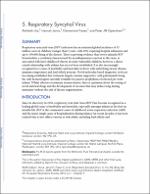Chapter 5 Respiratory Syncytial Virus
Author(s)
Jha, Akhilesh
Jarvis, Hannah
Fraser, Clementine
Openshaw, Peter
Collection
WellcomeLanguage
EnglishAbstract
Respiratory syncytial virus (RSV) infection has an estimated global incidence of 33 million cases in children younger than 5 years, with 10% requiring hospital admission and up to 199,000 dying of the disease. There is growing evidence that severe infantile RSV bronchiolitis, a condition characterised by an inflammatory reaction to the virus, is associated with later childhood wheeze in some vulnerable children; however, a direct causal relationship with asthma has not yet been established. It is also increasingly recognised as a cause of morbidity and mortality in those with underlying airway disease, immunocompromise and frail elderly persons. Novel molecular based diagnostic tools are becoming established but treatment largely remains supportive, with palivizumab being the only licensed agent currently available for passive prophylaxis of selected pre-term infants. Whilst effective treatments remain elusive, there is optimism about the testing of novel antiviral drugs and the development of vaccines that may induce long-lasting immunity without the risk of disease augmentation.
Keywords
viral lung disease, RSV, paediatric infections, bronchiolitis, mucosal immunityISBN
9781849840705Publisher
European Respiratory SocietyPublication date and place
Sheffield, 2016Grantor
Classification
Diseases and disorders


 Download
Download